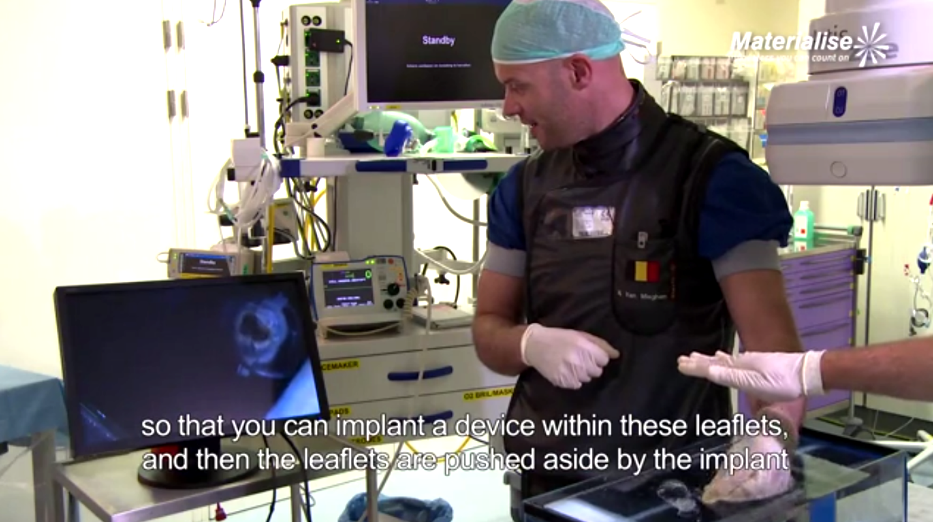Medical technology continues to evolve rapidly, and as we’ve already seen, 3D printing is coming along for the ride. Not content to take a passenger seat, though, 3D printing is hopping behind the wheel to really drive some major changes.![logo-erasmusmc-rgb-wit-nl[1]](https://3dprint.com/wp-content/uploads/2015/01/logo-erasmusmc-rgb-wit-nl1.jpg)
In the Netherlands, the Erasmus Medical Center has been working to bring 3D printing into the medical arena as an invaluable reference and training tool for any number of professionals. The Rotterdam-based medical center is joining up with the PCR‘s initiative, the PCR Valve Atlas. The Valve Atlas is an app used for reference and training, useful to all those who might need an on-hand source for valves, such as the aortic valve. Surgeons, interventionists, general practitioners, and other medical professionals value the Valve Atlas for its accessible information.
 Erasmus worked with the existing Valve Atlas to illustrate the transcatheter aortic valve implantation, or TAVI. The TAVI procedure replaces a patient’s damaged aortic valve through the use of a minimally invasive catheter. Since modeling presents a much more tangible way to demonstrate a procedure, especially compared to a flat diagram in a book or on a screen, the team from Erasmus turned to Materialise to create a 3D printed model of the aortic valve. Materialise is quickly gaining expertise in biomedical 3D printi
Erasmus worked with the existing Valve Atlas to illustrate the transcatheter aortic valve implantation, or TAVI. The TAVI procedure replaces a patient’s damaged aortic valve through the use of a minimally invasive catheter. Since modeling presents a much more tangible way to demonstrate a procedure, especially compared to a flat diagram in a book or on a screen, the team from Erasmus turned to Materialise to create a 3D printed model of the aortic valve. Materialise is quickly gaining expertise in biomedical 3D printi![]() ng applications.
ng applications.
The development of the model was a collaboration between these entities. Dr. Nicolas Van Mieghem was among those involved in ensuring the most accurate model possible. Dr. Van Mieghem, an interventional cardiologist at the Thorax Center in Rotterdam, discussed the steps to creating the perfect model, which had to be made of the right material in the best size and shape. Because the model will ultimately be used to train doctors on the intricate TAVI procedure, the accuracy of design had to be just right.
“The process to get the phantom model right was very interactive,” said Dr. Van Mieghem. “What kind of material do we want to use? Does it need to be flexible or more rigid? Do we want flexible leaflets? Are the leaflets important for this phantom model? The size was also very important.”
Once the model had been designed, Materialise created several prototypes. It didn’t take too many iterations, though, before it was just right, and the model was ready for action.
“You may gain a lot from making a mock-up of a patient’s anatomy before you actually perform the implantation. Once you have a 3D reconstruction, you can exercise and train yourself by implanting a device on this mock-up so that you are prepared to the maximum before the real implantation,” said Dr. Van Mieghem.
This model adds to a growing worldwide portfolio of such medical models that are popping up in hospitals and research facilities across the world. Surgeons and other professionals in the medical field will benefit from the ability to physically feel what the procedures will be like, which will only serve to benefit doctors and their patients alike.
What do you think about this new model for TAVI procedures? Check out the video below, in which Dr. Van Mieghem describes some of the development process. Join the discussion over at the 3D Printed TAVI Model forum thread at 3DPB.com.
https://vimeo.com/110257507
Subscribe to Our Email Newsletter
Stay up-to-date on all the latest news from the 3D printing industry and receive information and offers from third party vendors.
You May Also Like
3D Printing Financials: voxeljet’s Financial Reshuffle
In a series of significant announcements made on March 13, 2024, voxeljet (Nasdaq: VJET) has revealed a plan to reshape its financial structure and strategic direction. As part of these...
Japanese Aerospace Leader Invests in 3DEO and Its Metal 3D Printing Tech
Los Angeles-based metal 3D printing startup 3DEO has announced a key investment from IHI Aerospace Co., Ltd. (IA), a subsidiary of Japanese manufacturing leader IHI. This collaboration marks a significant...
2025 Renault 5 E-Tech Electric Is Latest Car with 3D Printed Accessories
Due to the required numbers, additive manufacturing (AM) has struggled to make significant inroads into vehicle interiors in meaningful numbers—at least as far as public knowledge is concerned. Typically an...
Interview: NAGASE Facilitates AM Adoption with EMPOWR3D 3D Printing Brand
The additive manufacturing (AM) market is entering a new phase in which large companies from outside of the segment have entered and begun consolidating. In reality, this trend has been...
































